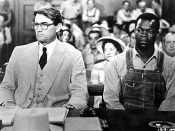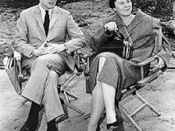In the novel To Kill A Mockingbird by Harper Lee, there are many recurrences of the theme of reason vs. madness. An all too familiar scene is when the mad Tim Johnson is seen "moseyin'" down the road by Jem and Scout and is put out of his misery by Atticus, who at first is reluctant to take the shot. This scene not only strengthens Atticus' character, but sets a prime example of how reason takes on the madness of the situation. This same theme is repeated in different forms throughout the novel and is very important as it serves to control other themes of the novel such as innocence.
One of the most obvious recurrences of this theme takes place at the Tom Robinson trial. Tom is convicted of raping a young white woman although he never actually committed any crime. Tom can bee seen as a parallel to Tim Johnson in a way because both are the objects of "madness" in each case.
Like Tim, Tom did not mean any harm, and what happened to him was completely out of his hands. This courthouse trial is also paralleled by another incident, the jail house mob. The mob gathers out of the hate they feel towards Tom, which is aroused by their blind prejudice, but there is reason in this madness. The pure innocence of the children convinces the angry crowd to look upon the situation in a different way, to overcome their ignorance by seeing truth. Atticus realizes that a change of heart has taken place and comments: "So it took an eight-year old child to bring 'em to their senses, didn't it?" The reason in all the madness, whether it be in the courthouse, at the jail house, or on that lonesome street, is the...


